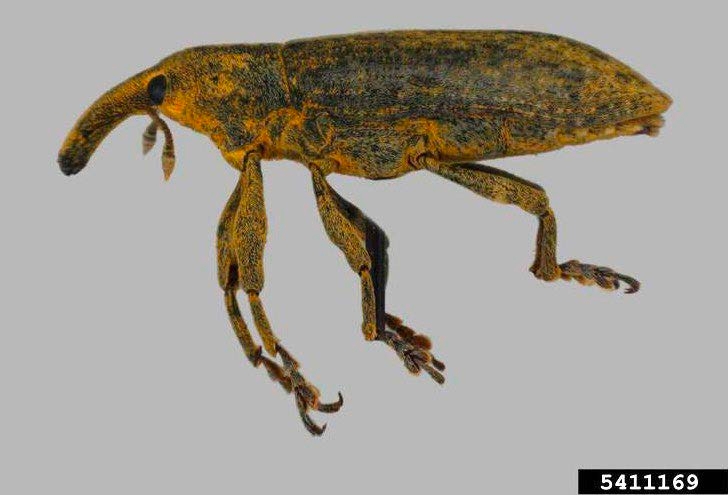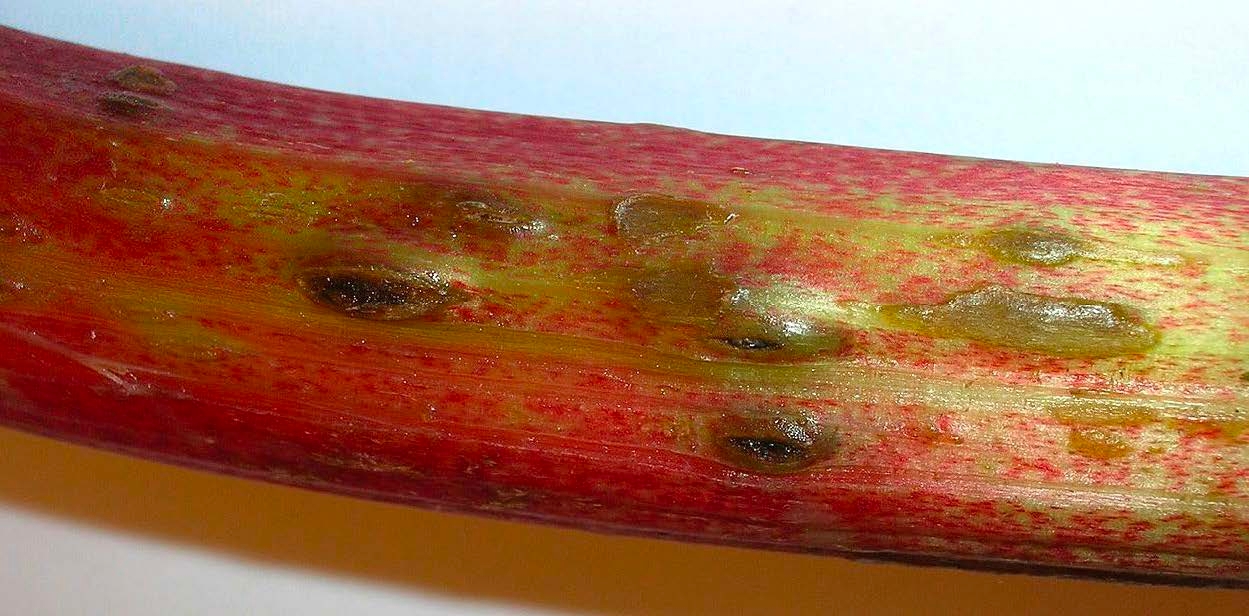Rhubarb Curculio
ID
3104-1563 (ENTO-430NP)
Introduction
Rhubarb curculio, Lixus concavus Say, belongs to the family Curculionidae in the order Coleoptera.
Description
Adult rhubarb curculios are elongated, somewhat cylindrical beetles measuring about 13-19 mm (0.5-0.75 inch) in total body length (Fig. 1). They have an obvious, long snout that curves downwards from the head. Young adults have a dusty coating of yellow or orange powder that rubs off easily. Older beetles that have lost this dusty coating appear brownish-black in color. Mature larvae are legless white grubs with a brown head capsule. Rhubarb curculio larvae are only found in weedy hosts and not in rhubarb itself. There are a number of related, similar-looking weevils that occur on various weeds in the Asteraceae and Polygonaceae families.

Range and Plants Attacked
Rhubarb curculio is native to North America and historically fed on native, weedy species of dock (Rumex spp,). The weevil adapted to feeding on rhubarb, a relative of dock, when the plant was introduced from Europe. Rhubarb weevil is found from New England west to Idaho and south to Florida and Louisiana. Rhubarb weevil also feeds on sunflower and thistles.
Damage
Adults notch the edges of leaves and stalks as they feed. They also make shallow, round or oval depressions on the stalks as they feed and oviposit there (Fig. 2). Injury by rhubarb curculio often goes unnoticed until drops of gummy sap appear on the rhubarb stalk at these feeding and oviposition sites. Dark streaks may appear on the stalks later as decay develops in these wounds.

Life History
Adults overwinter in plant debris and other protected locations. They become active in late spring and appear on the leaves of rhubarb and weedy hosts. Eggs deposited in rhubarb do not develop because they are crushed by rapidly growing plant tissues. Eggs laid in plant stalks of non-rhubarb hosts hatch into larvae in about 7-10 days. Larvae tunnel downwards through the stalk towards the crown and pupate at the base of non-rhubarb host plants in the soil. Adults emerge a few weeks later and feed until temperatures begin to drop, after which they find suitable protected locations to spend the winter. One generation of rhubarb curculio occurs annually.
Cultural Control
Handpick and destroy adults when found. They are often seen resting on the leaves of their host plants, but will drop off the plant quickly when disturbed. Place a bucket underneath to catch them.
Removing and destroying any weedy dock, thistle, and sunflower near rhubarb plantings in mid-summer will remove any larvae developing in those stalks. Adults overwinter in debris near the host plant, so removing dried rhubarb leaves and other debris from the rhubarb plantings in the fall may reduce the number of adults present the following spring.
Organic/Biological Control
There are no suitable organic or biological controls for rhubarb weevil at this time.
Chemical Control
Rhubarb curculio is only a sporadic pest of rhubarb and can be easily managed using cultural controls. Insecticide use to control rhubarb curculio is not recommended in either commercial production or home gardens.
Virginia Cooperative Extension materials are available for public use, reprint, or citation without further permission, provided the use includes credit to the author and to Virginia Cooperative Extension, Virginia Tech, and Virginia State University.
Virginia Cooperative Extension is a partnership of Virginia Tech, Virginia State University, the U.S. Department of Agriculture, and local governments. Its programs and employment are open to all, regardless of age, color, disability, sex (including pregnancy), gender, gender identity, gender expression, national origin, political affiliation, race, religion, sexual orientation, genetic information, military status, or any other basis protected by law
Publication Date
March 5, 2021



